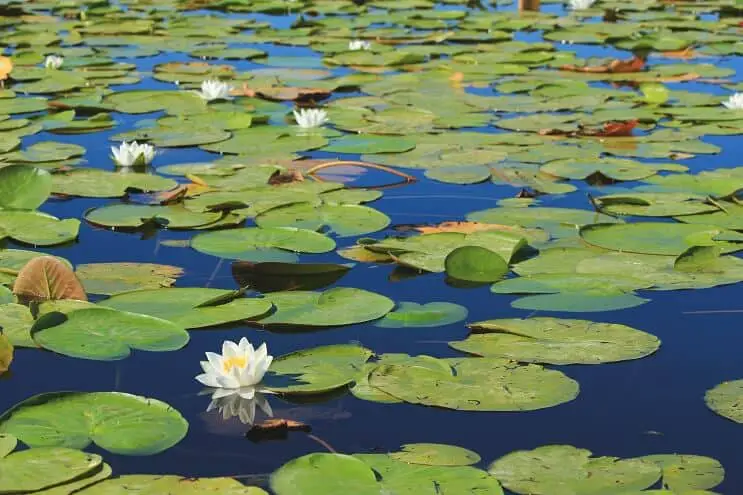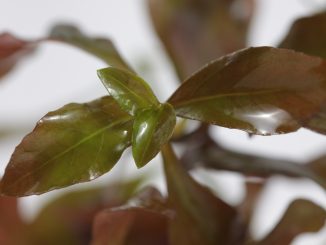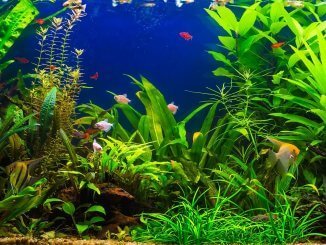
The dwarf water lily is a freshwater species that’s used as a floating plant in aquariums. Dwarf water lilies are miniature versions of water lilies.
The plant has flat, plate-like leaves that rest on the surface of the water, and produces white, pink, and yellow flowers in favorable conditions in the wild.
Dwarf water lilies are popular among aquarists because the plants are hardy and grow robustly without intervention.
TABLE OF CONTENTS
- Dwarf Water Lily Facts & Overview
- Appearance & Size
- Benefits of Dwarf Water Lilies in Aquariums
- Compatible Tank Mates
- Dwarf Water Lily Conditions & Requirements
- Tank Placement & Aquascaping
- Introducing Dwarf Water Lily in the Aquarium
- Care & Growing Guide
- Should You Get a Dwarf Water Lily for Your Aquarium?
Dwarf Water Lily Facts & Overview

| Scientific name: | Nymphaea nouchali |
| Common names | Dwarf water lily, miniature water lily, blue lotus, star lotus, blue star water lily, manel flower |
| Origin: | India, Bangladesh, Sri Lanka |
| Size: | Up to 4 inches tall |
| Growth rate: | Fast |
| Color: | Light green to gray-green leaves with white, pink, or yellow flowers |
| Aquarium placement: | Floating |
| Water type: | Freshwater |
| Temperature: | 72–82°F (22–28°C) |
| pH: | 5.0–8.0 |
Nymphaea nouchali is an extremely hardy plant and very easy to grow. It is an excellent choice for aquarist beginners who want to create a planted tank as it grows robustly and requires little maintenance.
Origin
The dwarf water lily is native to Bangladesh, Sri Lanka, and India, in South Asia. The plant is now found in places where it isn’t native — like the coastal US, Brazil, eastern Australia, and southern Africa — and it’s considered a pest in these regions.
The natural habitat of the dwarf water lily is still freshwater that gets lots of sunshine.
Availability
Dwarf water lilies are commonly available in pet stores, and cost between $7 and $30 depending on the variation of the plant. Most stores sell dwarf water lily bulbs with no leaves or roots, and you’ll need to grow the plant yourself.
You can buy dwarf water lilies from the following reputable online stores:
Appearance & Size
The dwarf water lily is a small floating plant with a leaf span of fewer than 5 inches and a height of up to 4 inches. This plant has rounded, waxy leaves that develop red and pink coloration as they grow.
In the right growing conditions in the wild, dwarf water lilies produce large, colorful flowers in the spring and summer that sit slightly raised above the water between the leaves. However, these flowers don’t form in captivity. The stems of the plant are long and vine-like, and the roots are short and cluster around the bulb.
Young dwarf water lilies have strong, thick roots and straight stamens (the pollen-producing parts of the flower), while old water lilies have thinned-out roots and curled or folded-in stamens.
There are two common types of dwarf water lilies: hardy and tropical. Hardy water lilies have flowers that float on the surface of the water, while tropical water lilies have flowers that protrude several inches above the water.
Benefits of Dwarf Water Lilies in Aquariums
Dwarf water lilies are attractive features in a home aquarium, and they offer practical benefits too.
These flowers provide cover for fish, and improve water chemistry by removing nitrate and phosphate from the tank. Egg-laying fish, like goldfish, lay their eggs on the underside of the plants.
Compatible Tank Mates
Shy fish that prefer to hide away from their tank mates are likely to emerge from hiding if they’re in the shadow of dwarf water lilies.
Fish that particularly benefit from dwarf water lilies are:
Avoid herbivorous fish, like silver dollar fish, that eat plants like the dwarf water lily. Water lilies can grow in a tank with other plants, but they cover the surface of the water. They can block light from reaching plants growing further down in the tank.
Dwarf Water Lily Conditions & Requirements

Caring for a dwarf water lily is easy as long as you mimic the plant’s natural habitat and provide it with the nutrients it needs to thrive. Heavy soil or pure clay soil is the best substrate for growing dwarf water lilies.
Tank Requirements
The dwarf water lily’s natural habitat is still, quiet, freshwater lakes and ponds, with warm, slightly acidic water. Provide a similar environment in a home aquarium, with the right water conditions for the plant to thrive.
As long as they have a low-to-medium light source and access to nitrates and phosphates from the tank’s fish inhabitants, dwarf water lilies should grow healthily in the tank.
Choose a clay or heavy soil substrate to plant the dwarf water lily in, and fill the tank with soft water with a pH of 5.0–8.0 and a temperature of 72–82°F.
Tank Conditions
Dwarf water lilies are adaptable to a variety of water conditions as long as their other tank conditions remain consistent.
Ideal tank conditions for a dwarf water lily are:
| Water type: | Slightly acidic, soft freshwater |
| Tank size: | Minimum 10 gallons, or 20 gallons if you don't trim the plant |
| Water temperature: | 72–82°F (22–28°C) |
| Substrate: | Soil or clay substrate |
| Tank placement: | Floating |
| Acidity: | 5.0–8.0 pH |
| Water hardness: | 3–11 dGH |
| Water heater: | Yes, to maintain warm water |
| Light type & strength: | Low to moderate aquarium lighting |
| Hours of light: | Around 12 hours |
Tank Placement & Aquascaping
The dwarf water lily floats on top of the water and grows upward from the substrate.
To prevent the plant’s stems from blocking your view into the tank, plant the bulbs at the back of the tank. The plants should be planted individually or in small groups of three or four, depending on the size of the tank.
The bigger the tank, the more dwarf water lilies can be grown together.
Introducing Dwarf Water Lily in the Aquarium
To introduce a dwarf water lily bulb in the aquarium, follow these steps:
- Remove the dwarf water lily bulb from its packaging and wash it in water to remove loose soil. Bulbs don’t need to be quarantined or washed in special solutions before being introduced to the tank.
- Place the bulb on top of the soil or clay substrate and gently press to keep the bulb in place. Don’t bury the bulb in the substrate because this causes the bulb to rot. If the bulb floats, submerge it in a bucket of dechlorinated water for two hours before adding it back into the main tank.
- Observe the bulb for the next few days. When leaves begin to sprout, push the bulb into the substrate to bury its bottom half. The roots will grow, anchoring the bulb in place
Care & Growing Guide

Dwarf water lilies are easy to care for because they’re hardy and quick to grow without intervention or special nutrients.
Nutrition
The dwarf water lily thrives in water containing nitrate and phosphate. Tanks with fish naturally have high nitrate and phosphate levels because these chemicals are found in fish waste.
So, if you add dwarf water lilies to a fish tank, you won’t need to supplement the tank with additional nitrate and phosphate.
Usually, dwarf water lilies grow fine without fertilizer or CO2. If you want to encourage fast growth, adding fish-safe fertilizer to the tank should help.
Maintenance
Dwarf water lilies aren’t susceptible to disease, but there are several common problems to watch out for:
- Algae growth: If algae is allowed to grow heavily on the plant, algal blooms may form, which steal the oxygen that the plant needs. Prevent algae growth by regularly pruning the plant
- Bulb decay: If a bulb is set too deep in the substrate may decay, turning grayish and shriveled. Prevent bulb decay by planting the bulb above the surface of the substrate
- Lack of fertilizer: If the plant’s leaves turn brown or begin to drop off, this indicates a lack of nutrients. Encourage healthy growth by adding fish-safe fertilizer pellets to the tank
Prevent dwarf water lilies from overcrowding the surface of the tank with leaves because this reduces oxygen exchange, potentially killing the tank’s inhabitants.
To prune the plant, cut or pinch off several of the surface leaves to contain the plant within one section of the tank. Trim the plant back whenever it begins to cover more than one-third of the tank’s surface, or when algae forms on the top leaves.
Algae growth can harm dwarf water lilies. Adding shrimp, algae eaters, and snails to the tank controls algae growth on the plants.
Propagation
As long as dwarf water lilies are grown in the right water conditions, the plant will propagate themselves without needing extra care.
After several months of healthy growth, the plant will begin to send out offshoots with baby plants attached. Use a sharp knife or scissors to cut off these shoots and replant them in the substrate in other sections of the tank where you’d like to grow more plants.
Should You Get a Dwarf Water Lily for Your Aquarium?
Dwarf water lilies are pretty, low-maintenance plants that are ideal for beginner aquarists.
You should get a dwarf water lily if you want a hardy plant that doesn’t require much pruning or fertilizing.
Don’t get this plant if your tank contains herbivorous fish that eat plants, or if you don’t have enough space for a fast-growing plant.
Despite their inability to produce flowers under aquarium conditions, dwarf water lilies are still attractive plants that add vibrant greenery to a planted tank.







Be the first to comment